The Fed Ultimatum
Posted On Tuesday, Feb 01, 2022
The bond market started the new year on shaky ground. US Federal Reserve’s dramatic shift from “inflation is transitory” talk of September 2021 to “inflation is the biggest threat to employment” in December 2021 rocked the market sentiment.
Forced by its own change in the inflation characterisation, the Fed sent out an ultimatum to the bond markets to prepare for tighter financial conditions – lesser liquidity and higher interest rates (The Great Divergence).
Minutes of the December FOMC meeting noted – “...current conditions included a stronger economic outlook, higher inflation, and a larger balance sheet and thus could warrant a potentially faster pace of policy rate normalization.”
It also highlighted - “Almost all participants agreed that it would likely be appropriate to initiate balance sheet runoff at some point after the first increase in the target range for the federal funds rate…Many participants judged that the appropriate pace of balance sheet runoff would likely be faster than it was during the previous normalization episode.”
It is now widely expected that the Fed will hike the Fed Funds rate 4 times in 2022 and 4 times in 2023. This implies a total rate increase of 200 basis points over the next 2 years from the current zero bound.
Chart – I: Bond Markets Pricing Faster Rate Hikes
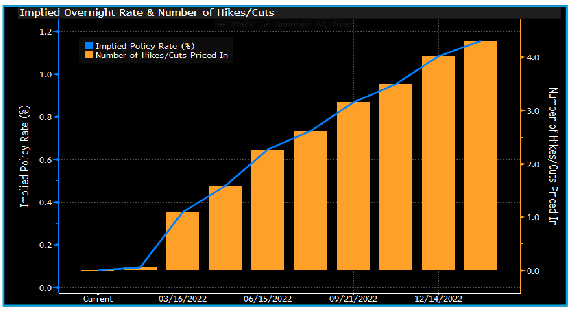
Source – Bloomberg, Data as of January 18, 2022
Fed may also begin reducing its balance sheet by the middle of 2022 – by not reinvesting maturing securities and even selling securities from its balance sheet (Quantitative Tightening). It reduces liquidity in the financial markets and puts downward pressure on asset prices.
Chart – II: Fed fund rate at life low and FED balance sheet highest ever
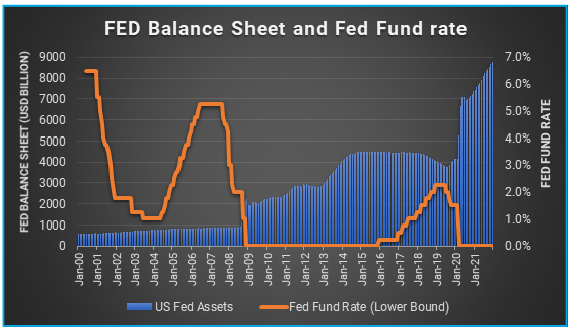
Source – Bloomberg, Quantum Research, Data up to December 31, 2021
Bond Rout
Bond markets did expect a policy normalisation to start in 2022. But, a possibility of four rate hikes and quantitative tightening was far from the imagination of even the most hawkish of market participants.
Bonds sold off – bond yields rose and bond prices fell. The US 10-year treasury yield surged more than 32 basis points (0.32%) since the FOMC statement on December 15, 2021. Currently, it is hovering around 1.79%.
In India, the 10-year G-sec yields jumped 29 basis points from 6.36% on December 15, 2021, to 6.65% on January 24, 2022.
Chart - III: Bond Yields Jumped after FED’s Hawkish Shift
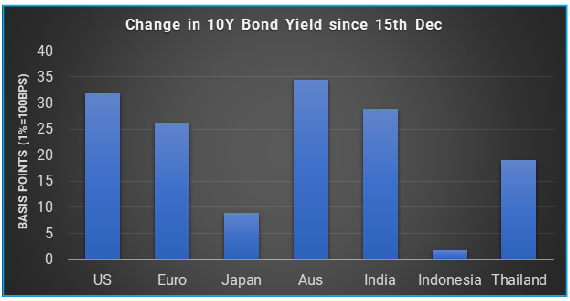
Source: Refinitiv, Quantum Research, Data as of January 24, 2022
How far will the Fed go to tackle inflation?
This is a difficult question to even take a guess at this stage - when the consumer inflation in the US is at 7% (vs Fed’s target of 2% inflation), yet the federal funds rate is at zero and the Fed will be printing an additional USD 60 billion to buy bonds in January 2022.
This doesn’t go along with the Fed’s commentary on inflation risk and its guidance on the policy roadmap.
The only explanation could be that the Federal reserve is still very touchy about financial markets is not ready to withdraw the ‘Fed PUT’ as yet (refer to The Das PUT).
Based on a simple extrapolation we can assume that any notable volatility in the financial markets will force the Fed to backpedal on policy normalisation. Furthermore, given the increased size of the debt, global growth has become even more sensitive to interest rate changes. Thus, the FED may not be able to hike rates and tighten liquidity at a faster pace without breaking something in the markets and the economy.
To sum up, the Fed will continue to use the market feedback to adjust the pace of rate hikes and balance sheet reduction and will not be able to tighten the financial conditions too much.
What lies ahead?
With few exceptions, Central banks around the world are moving towards policy normalisation. This entails lesser liquidity support, higher short term funding rates and tighter financial conditions going ahead.
Against this backdrop, it would be difficult for the RBI to maintain the current accommodative stance. We should expect the RBI to hike rates and reduce the liquidity support in 2022.
However, India’s growth inflation dynamics are very different from that in the US. A large part of the domestic economy is still below its pre-pandemic levels. This can be seen in the sluggish private consumption expenditure, lagging services sector performance and lower employment levels compared to pre-pandemic trends.
Chart – IV: Large Part of Economy is Still below Pre-Pandemic Levels
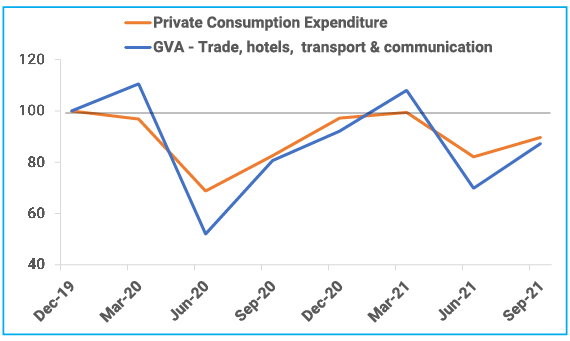
Source: CMIE Database, Quantum Research, Data up to September 30, 2021 Data is rebased to 100 on 31 Dec 2019
A faster normalisation of monetary policy could hamper the ongoing economic recovery. We expect the RBI to be gradual in reducing liquidity and hiking interest rates.
We also expect the terminal repo rate to remain below its pre-pandemic normal and overall liquidity conditions to remain in comfortable surplus in foreseeable future (Investing in The New Normal).
From the market’s standpoint, this outcome is widely expected and is already factored in the current bond prices. However, the external environment remains highly uncertain and will continue to induce significant volatility in the bond and currency markets.
The biggest risk for the market is a faster balance sheet reduction via bond sales by the US Federal Reserve. Markets will test the Fed’s resolve for controlling inflation by tightening the financial conditions.
Bonds Outlook
Since the start of 2021, bond yields have risen a lot in expectation of liquidity tightening and eventual rate hikes. Thus, gradual rate increases which are well communicated will be absorbed comfortably. However, we may continue to see a gradual increase in short term yields as central banks increase rates and reduce liquidity.
Chart – V: Rate Hike Expectation Pushed Bond Yields Higher
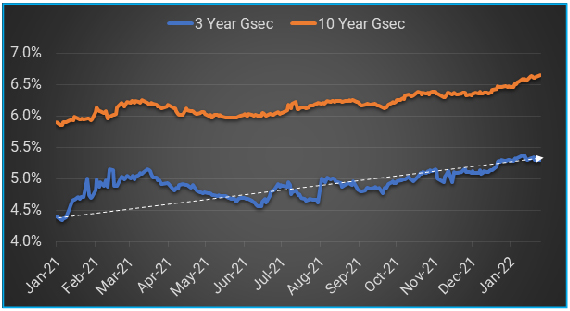
Source – Bloomberg, Quantum Research, Data up to January 24, 2022.
Past Performance may or may not sustained in future.
Long term bond yields may remain range-bound around current levels or move up only marginally as we expect this rate hiking cycle to be much shallower with the RBI trying to keep the terminal repo rate closer to 5.0%-5.5% (Refer Investing in The New Normal). This assessment was based on the fact that much of domestic inflation is coming from supply chain disruptions and one-off price adjustments which should fade away over the period.
Long-term bond yields, though, face risks from the abrupt change in stance from central banks. India faces this risk from an increase in global crude oil prices. This would force the RBI to hike interest rates sharply and markets could face higher volatility.
With the RBI hiking the policy repo rates and withdrawing its liquidity support to the market, money market rates should rise.
Chart – VI: Short term interest rates to move higher
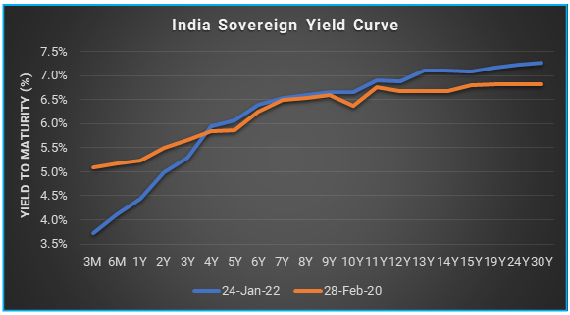
Source: Refinitiv, Quantum Research, Data as of January 24, 2021.
Past Performance may or may not sustained in future.
2020 and early parts of 2021 saw returns on medium to long-term bonds/bond funds soaring as interest rates fell. At the same time, returns on overnight, liquid, money market funds fell.
The best way to play the rate hiking cycle is to focus on the short maturity segments of the market. Investors in liquid funds and money markets funds should see their returns improve as compared to bank savings accounts. Low market risk, cash equivalents seem to be the best option from a risk/return perspective.
Portfolio Allocation - Defensive and Dynamic
Although the macro backdrop is unfavourable (high inflation, monetary tightening), valuation in 2-6 years government bonds looks comfortable. In our opinion, this segment is already pricing much of the liquidity normalization (lowering of liquidity surplus) and a gradual rate hiking cycle.
Given the steep bond yield curve, 2-6 years bonds also offer the best roll-down potential and thus a reasonable margin of safety from rising bond yields. For instance, currently, the yield on the 5 years government bond is around 6.07% and that on the 4 years bond is at 5.80%. After one year, the current 5-year bond will have a residual maturity of 4 years. Assuming no change in market interest rates, the yield on the current 5-year bond should roll down by 22 basis points to 5.80%. (Data as of January 24, 2022)
The bulk of our holding in the Quantum Dynamic Bond Fund is in the 2-6 years maturity segment.
We recognize that the monetary policy is in a transition phase in India and across the world. If history is any guide, these transitions from easing to tightening monetary policy tend to become chaotic with a lot of sentimental and divergent market movements on both sides. Thus, we should be prepared for increased volatility in the bond market over the next few months.
We are closely monitoring the developments around the Omicron variant and its impact on the monetary and fiscal policies. We stand vigilant to react and change the portfolio positioning in case our view on the market changes.
From investors’ perspective, we believe a combination of liquid to money market funds to benefit from the increase in interest rates in the coming months; along with an allocation to short term debt funds and/or dynamic bond funds with low credit, risks should remain as the core fixed income allocation.
We suggest bond fund investors have a longer holding period to ride through any intermittent turbulence in the market.
For any queries directly linked to the insights and data shared in the newsletter, please reach out to the author – Pankaj Pathak, Fund Manager – Fixed Income at [email protected].
For all other queries, please contact Neeraj Kotian – Area Manager, Quantum AMC at [email protected] / [email protected] or call him on Tel: 9833289034
Read our last few Debt Market Observer write-ups -
- The Great Divergence
- The Monetary Transition
| Name of the Scheme | This product is suitable for investors who are seeking* | Riskometer |
| Quantum Liquid Fund An Open-ended Liquid Scheme. A relatively low interest rate risk and relatively low credit risk. | • Income over the short term • Investments in debt / money market instruments | 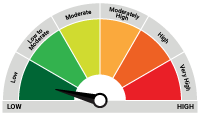 Investors understand that their principal will be at Low Risk |
| Quantum Dynamic Bond Fund An Open-ended Dynamic Debt Scheme Investing Across Duration. A relatively high interest rate risk and relatively low credit risk. | • Regular income over short to medium term and capital appreciation • Investment in Debt / Money Market Instruments / Government Securities | 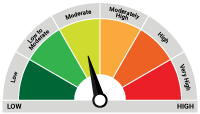 Investors understand that their principal will be at Moderate Risk |
The Risk Level of the Scheme in the Risk O Meter is based on the portfolio of the scheme as on December 31, 2021.
| Potential Risk Class Matrix - Quantum Liquid Fund | |||
| Credit Risk → | Relatively Low | Moderate (Class B) | Relatively High (Class C) |
| Interest Rate Risk↓ | |||
| Relatively Low (Class I) | A-I | ||
| Moderate (Class II) | |||
| Relatively High (Class III) | |||
| Potential Risk Class Matrix – Quantum Dynamic Bond Fund | |||
| Credit Risk → | Relatively Low | Moderate (Class B) | Relatively High (Class C) |
| Interest Rate Risk↓ | |||
| Relatively Low (Class I) | |||
| Moderate (Class II) | |||
| Relatively High (Class III) | A-III | ||
Disclaimer, Statutory Details & Risk Factors:
The views expressed here in this article / video are for general information and reading purpose only and do not constitute any guidelines and recommendations on any course of action to be followed by the reader. Quantum AMC / Quantum Mutual Fund is not guaranteeing / offering / communicating any indicative yield on investments made in the scheme(s). The views are not meant to serve as a professional guide / investment advice / intended to be an offer or solicitation for the purchase or sale of any financial product or instrument or mutual fund units for the reader. The article has been prepared on the basis of publicly available information, internally developed data and other sources believed to be reliable. Whilst no action has been solicited based upon the information provided herein, due care has been taken to ensure that the facts are accurate and views given are fair and reasonable as on date. Readers of this article should rely on information/data arising out of their own investigations and advised to seek independent professional advice and arrive at an informed decision before making any investments.
Mutual fund investments are subject to market risks read all scheme related documents carefully.
Please visit – www.quantumamc.com/disclaimer to read scheme specific risk factors. Investors in the Scheme(s) are not being offered a guaranteed or assured rate of return and there can be no assurance that the schemes objective will be achieved and the NAV of the scheme(s) may go up and down depending upon the factors and forces affecting securities market. Investment in mutual fund units involves investment risk such as trading volumes, settlement risk, liquidity risk, default risk including possible loss of capital. Past performance of the sponsor / AMC / Mutual Fund does not indicate the future performance of the Scheme(s). Statutory Details: Quantum Mutual Fund (the Fund) has been constituted as a Trust under the Indian Trusts Act, 1882. Sponsor: Quantum Advisors Private Limited. (liability of Sponsor limited to Rs. 1,00,000/-) Trustee: Quantum Trustee Company Private Limited. Investment Manager: Quantum Asset Management Company Private Limited. The Sponsor, Trustee and Investment Manager are incorporated under the Companies Act, 1956.
Related Posts
-

The Pivot
Posted On Friday, Apr 21, 2023
The fiscal year 2022-23 has come to an end. The defining feature
Read More -

Yield Curve Inversion Ahead
Posted On Thursday, Mar 23, 2023
Indian money markets have tightened meaningfully over the last one and a half month.
Read More -

Past, Present, and Future of Inflation
Posted On Friday, Feb 24, 2023
Inflation has been one of the biggest challenges in the post-pandemic world.
Read More



